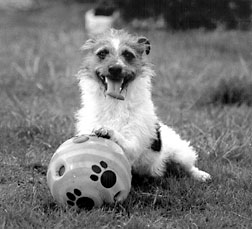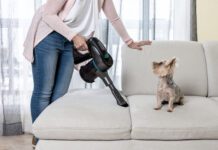As we were going to press with this issue, we received a report of a dogs death due to ingestion of a small part contained in a toy called the Wiggly Giggly ball. The noisemaking whistles in the interior of the ball may provide a lethal dose of zinc if ingested.
While we have been unable to confirm the report of the poisoned dog, we did contact both the maker and the seller of the Wiggly Giggly ball, and confirmed that the balls did, in fact, contain small discs of zinc, at least, until very recently.
According to Andrew Farrar, partner and CEO of HandsOn Toys of Wilmington, Massachusetts, maker of the toys, zinc discs were used as weights inside the toy. These weights were positioned inside a plastic tube that was inside another tube, which was inside a third tube inside the ball.

Alerted by a pet owner a couple of months ago that her dog had managed to chew through the ball and all three tubes (she was concerned that dogs may break their teeth on the metal pieces), Farrar immediately ordered a design change, replacing the zinc discs with crushable stone pieces that pose no danger if eaten by a dog.
According to Farrar, more than two million of the toys have been sold in the last three years, both as a toy for dogs and for children, who presumably also enjoy the erratic movement of the ball and its amusing noises and who (presumably) would be unlikely to chew the ball open and risk exposure to small, swallowable parts.
Farrar warns that if a dog has chewed a Wiggly Giggly ball open, it should be taken away from the dog immediately a warning that has always appeared on the packaging of the Wiggly Giggly toy. Farrar adds, however, if a consumer believes that a dog has ingested a weight from the interior of one of the balls, the dog owner should contact a veterinarian immediately and have the dog examined.
We greatly appreciated the potential hazards of zinc being brought to our attention, says Farrar. We had already initiated a change to the manufacturing process to make the toy safer. Wiggly Giggly toys have been enjoyed by hundreds of thousands of dogs. While any traumatic event is too many, we are committed to bringing safe and engaging toys to the pet market.
Rich Rivlin, president of the company that markets the ball to dog owners (Multipet International of Moonachie, New Jersey), also expressed his concern for the family of the dog that died. We are all pet lovers, and we pride ourselves on selling fun, safe toys for dogs to enjoy with their people, he said.
Poor durability
WDJ included the Wiggly Giggly ball in a review of toys in our September 2000 issue. We noted that while some dogs are highly engaged by the noisemaking ball, a dog who is prone to chewing on his toys can easily tear the soft plastic ball open. The balls lack of durability, we noted, makes it an inappropriate toy for dogs who chew their toys, simply due to the fact that it contains small parts. We also noted that if the toy is ripped, it should be discarded immediately.
However, we were unaware that the product contained zinc. While any small metal item that is swallowed by a dog is potentially life-threatening, a zinc item poses special dangers.
Sources of zinc poisoning
According to the Textbook of Veterinary Internal Medicine (2000, W. B. Saunders Company), dogs are susceptible to zinc poisoning if they ingest any number of things that contain zinc. Reportedly, zinc poisoning has been caused by ingestion of pennies minted after 1983 (these pennies are 96 percent zinc), zinc nuts on some dog crates, and galvanized drip points on metal fences. Zinc can also leach out of galvanized dishes into particularly acidic food or water.
The textbook explains that signs of zinc poisoning may include depression, abdominal discomfort, vomiting, diarrhea, and anorexia. A veterinarian examining the dog would find elevated pancreatic and hepatic enzymes and evidence of anemia. Radiographs of the dogs abdomen often provide the first evidence of a metal object that has been swallowed.
Immediate treatment is needed to save a dog with zinc poisoning. The swallowed object must be immediately removed with surgery, blood transfusions may be needed, and fluid therapy will be needed to correct fluid loss and electrolyte imbalances and improve renal function. Chelation therapy should also be administered.
Any toy poses some danger
Dogs should never be left unattended with any toy that they can chew up or swallow. Toys with small parts, batteries, flashing lights, or electronic pieces inside should be given to dogs to play with only when you are closely supervising their activity. If the phone rings or someone comes to the door, pick up that toy first! And owners of dogs that do tend to chew or destroy toys should consider never having this type of toy in the house, in case the dog is able to find where youve hidden it.
The Kong is a good example of a toy that can be safely left with most dogs, but very aggressive chewers have been known to shred even the strongest Kongs. Bottom line: When youre not paying rapt attention to your dog, take his toys away.






